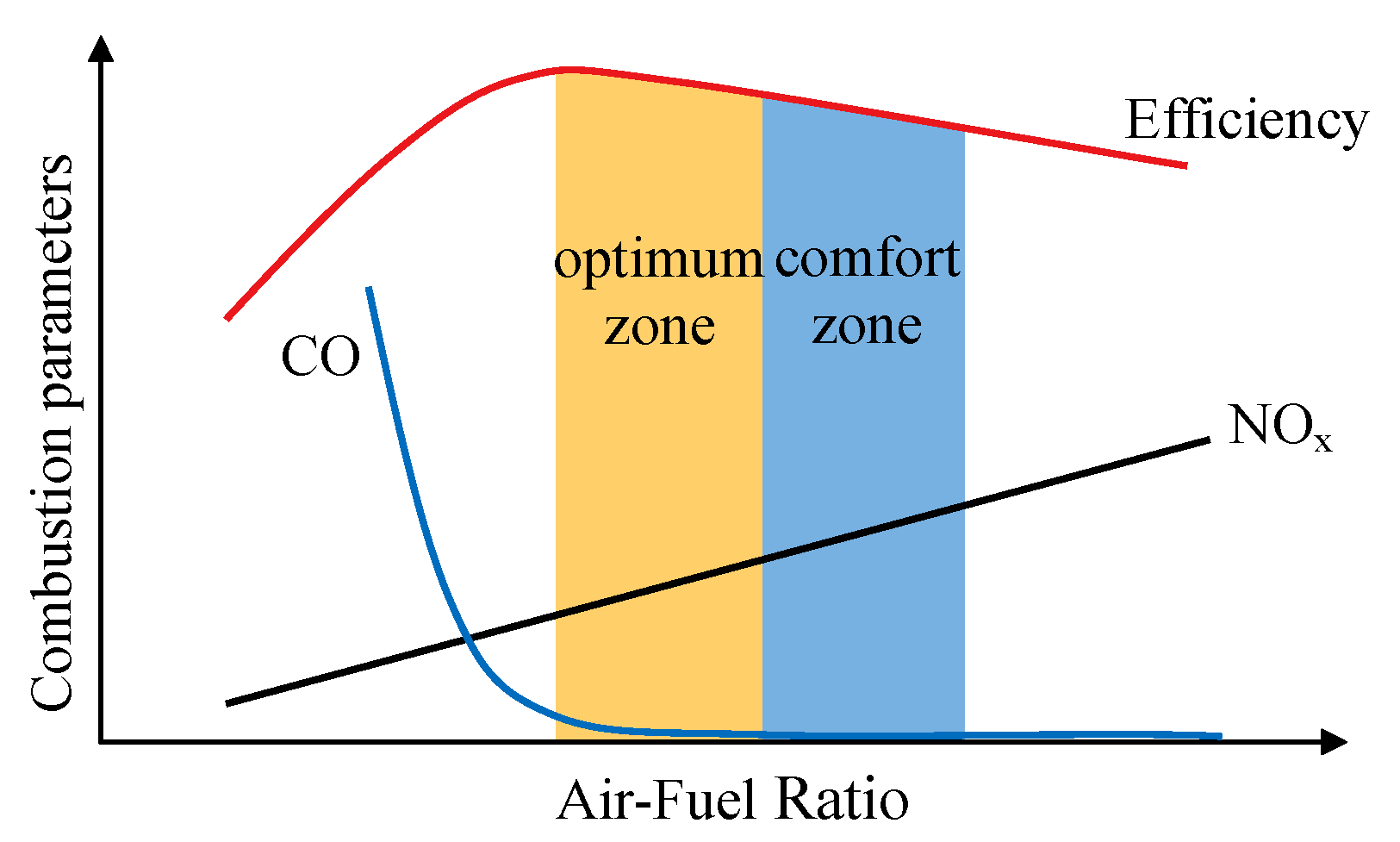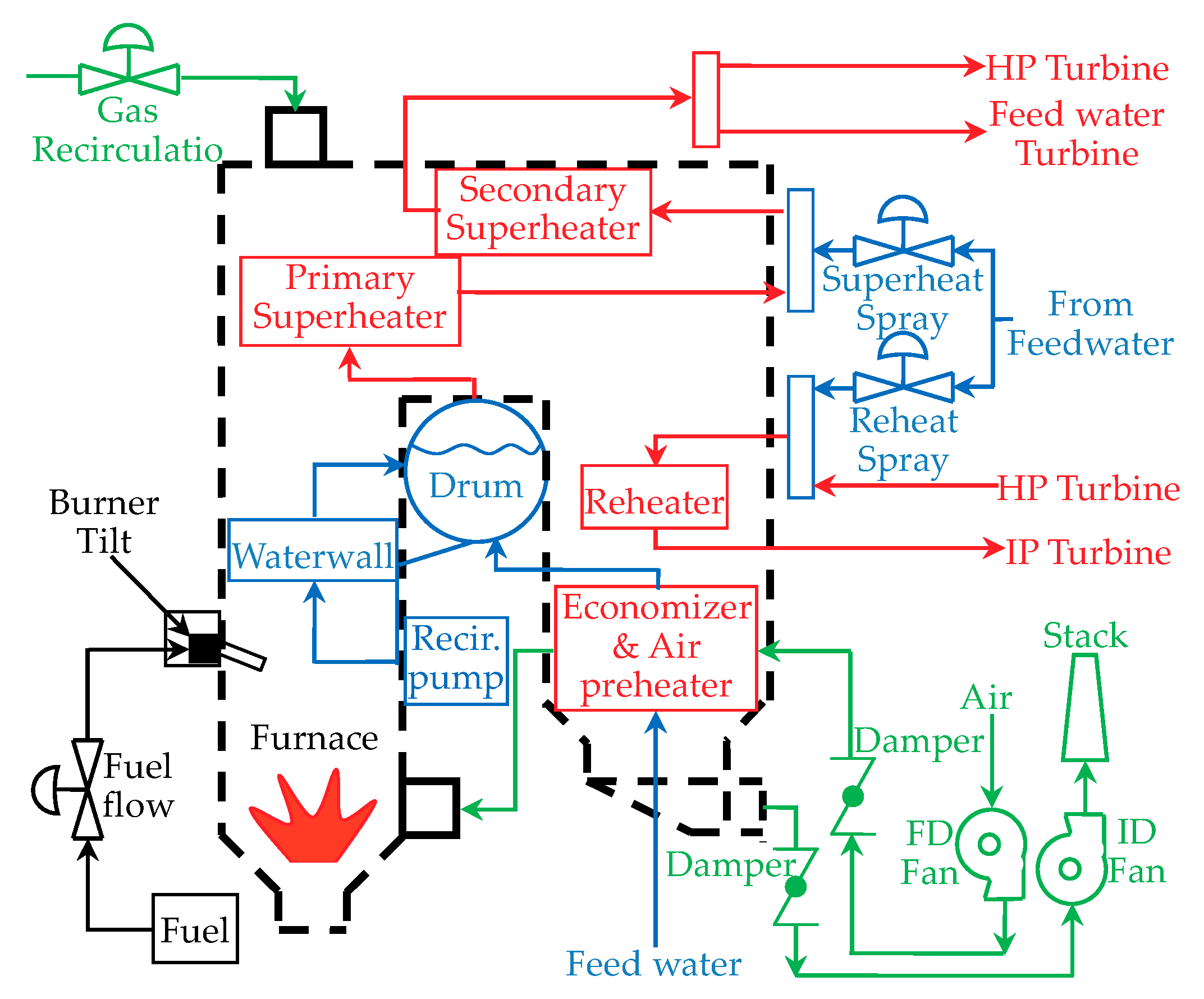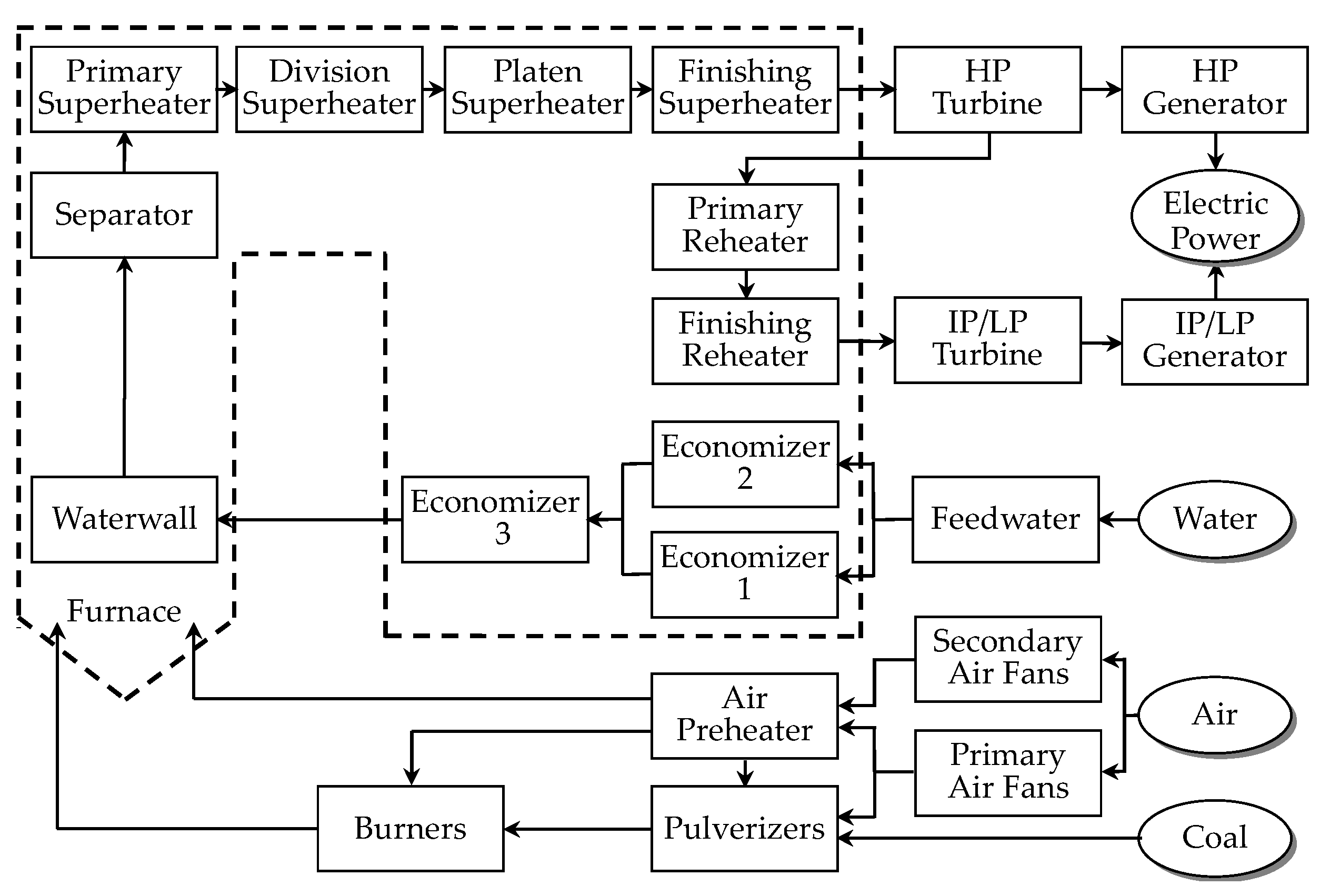Supplementary Control of Air–Fuel Ratio Using Dynamic Matrix Control for Thermal Power Plant Emission
Abstract
:1. Introduction
2. DMC Combustion Control
2.1. Conventional Boiler Combustion
2.2. Supplementary DMC for AFR
2.3. Constraints of Proposed DMC
3. Applications to Power Plants
3.1. 600-MW Drum-Type Thermal Power Plant
3.2. 1000-MW Once-Through Type Thermal Power Plant
4. Simulation Results
4.1. Simulation of 600-MW Drum-Type Thermal Power Plant
4.2. Simulation of 1000-MW Once-Through Type Thermal Power Plant
5. Conclusions
Author Contributions
Funding
Conflicts of Interest
References
- Lewtas, J. Air pollution combustion emissions: Characterization of causative agents and mechanisms associated with cancer, reproductive, and cardiovascular effects. Rev. Mutat. Res. 2007, 636, 95–133. [Google Scholar] [CrossRef] [PubMed]
- Streets, D.G.; Waldhoff, S.T. Present and future emissions of air pollutants in China: SO2, NOx and CO. Atmos. Environ. 2000, 34, 363–374. [Google Scholar] [CrossRef]
- Wiatros-Motyka, M. Optimising Fuel Flow in Pulverised Coal and Biomass-Fired Boilers; IEA Clean Coal Centre: London, UK, 2016. [Google Scholar]
- Li, S.; Xu, T.; Hui, S.; Wei, X. NOx emission and thermal efficiency of a 300MWe utility boiler retrofitted by air staging. Appl. Energy 2009, 86, 1797–1803. [Google Scholar] [CrossRef]
- Dukelow, S.G. The Control of Boilers; Instrument Society of America, Research Triangle Park: North Carolina, USA, 1986. [Google Scholar]
- Wang, Y.; Yu, X. New coordinated control design for thermal-power-generation units. IEEE Trans. Ind. Electron. 2010, 57, 3848–3856. [Google Scholar] [CrossRef]
- Wei, L.; Fang, F. H∞-LQR-based coordinated control for large coal-fired boiler–turbine generation units. IEEE Trans. Ind. Electron. 2017, 64, 5212–5221. [Google Scholar] [CrossRef]
- Takiyama, T.; Shiomi, E.; Morita, S. Air–fuel ratio control system using pulse width and amplitude modulation at transient state. JSAE Rev. 2001, 22, 537–544. [Google Scholar] [CrossRef]
- Bhowmick, M.; Bera, S.C. An approach to optimum combustion control using parallel type and cross-limiting type technique. J. Process Control 2012, 22, 330–337. [Google Scholar] [CrossRef]
- Liu, Z.H.; He, G.X.; Wang, L.Z. Optimization of furnace combustion control system based on double cross-limiting strategy. In Proceedings of the 2010 International Conference on Intelligent Computation Technology and Automation, Changsha, China, 11–12 May 2010; pp. 858–861. [Google Scholar]
- Zanoli, S.M.; Barchiesi, D.; Astolfi, G.; Barboni, L. Advanced control solutions to increase efficiency of a furnace combustion process. In Proceedings of the European Control Conference (ECC), Zurich, Switzerland, 17–19 July 2013; pp. 4316–4321. [Google Scholar]
- Hou, Z.; Xiong, S. On Model-Free Adaptive Control and its Stability Analysis. IEEE Trans. Auto. Control 2019. [Google Scholar] [CrossRef]
- Bara, O.; Fliess, M.; Join, C.; Day, J.; Djouadi, S.M. Toward a model–free feedback control synthesis for treating acute inflammation. J. Theor. Biol. 2018, 478, 26–37. [Google Scholar] [CrossRef] [Green Version]
- Safaei, A.; Mahyuddin, M.N. Optimal model–free control for a generic MIMO nonlinear system with application to autonomous mobile robots. Int. J. Adapt. Control Signal Process. 2018, 32, 792–815. [Google Scholar] [CrossRef]
- Lee, S.D.; Bae, Y.G.; Jung, S. A Decentralized Model Identification Scheme by Random-walk RLS Process for Robot Manipulators: Experimental Studies. J. Control Autom. Syst. 2019, 17, 1856–1865. [Google Scholar] [CrossRef]
- Roman, R.C.; Precup, R.E.; Radac, M.B. Model–free fuzzy control of twin rotor aerodynamic systems. In 2017 25th Mediterranean Conference on Control and Automation (MED); IEEE: Valletta, Malta, 2017; pp. 559–564. [Google Scholar]
- Precup, R.E.; Radac, M.B.; Roman, R.C.; Petriu, E.M. Model–free sliding mode control of nonlinear systems: Algorithms and experiments. Inf. Sci. 2017, 381, 176–192. [Google Scholar] [CrossRef]
- Roman, R.C.; Precup, R.E.; David, R.C. Second Order Intelligent Proportional-Integral Fuzzy Control of Twin Rotor Aerodynamic System. Procedia Comput. Sci. 2019, 139, 372–380. [Google Scholar] [CrossRef]
- Kim, D.; Oh, H.S.; Moon, I.C. Black-box Modeling for Aircraft Maneuver Control with Bayesian Optimization. J. Control Autom. Syst. 2019, 17, 1558–1568. [Google Scholar] [CrossRef]
- Roman, R.C.; Radac, M.B.; Precup, R.E.; Petru, E.M. Virtual reference feedback tuning of model–free control algorithms for servo systems. Machines 2017, 5, 25. [Google Scholar] [CrossRef]
- Qin, S.; Badgwell, T. A survey of industrial model predictive control technology. Control Eng. Pract. 2003, 11, 733–764. [Google Scholar] [CrossRef]
- Gracia, C.E.; Prett, D.M.; Morari, M. Model predictive control: Theory and practice−A survey. Automatica 1989, 25, 335–348. [Google Scholar] [CrossRef]
- Lee, J.H. Model predictive control in the process industries: Review, current status and future outlook. In Proceedings of the 2nd Asian Control Conference, Seoul, Korea, 22–25 July 1997; pp. 435–438. [Google Scholar]
- Moon, U.C.; Lee, K.Y. Step-response model development for dynamic matrix control of a drum-type boiler-turbine system. IEEE Trans. Energy Convers. 2009, 24, 423–430. [Google Scholar] [CrossRef]
- Moon, U.C.; Lee, Y.; Lee, K.Y. Practical dynamic matrix control for thermal power plant coordinated control. Control Eng. Pract. 2018, 71, 154–163. [Google Scholar] [CrossRef]
- Lee, Y.; Yoo, E.; Lee, T.; Moon, U.C. Supplementary control of conventional coordinated control for 1000MW ultra-supercritical thermal power plant using dynamic matrix control. J. Electr. Eng. Technol. 2018, 13, 97–104. [Google Scholar]
- Moon, U.C.; Lee, K.Y. An adaptive dynamic matrix control with fuzzy-interpolated step-response model for a drum-type boiler-turbine system. IEEE Trans. Energy Convers. 2011, 26, 393–401. [Google Scholar] [CrossRef]
- Usoro, P.B. Modeling and Simulation of a Drum Boiler-Turbine Power Plant under Emergency State Control. Master’s Thesis, Massachusetts Institute. Technology, Cambridge, MA, USA, May 1977. [Google Scholar]
- Heo, J.S.; Lee, K.Y. A multiagent-system-based intelligent reference governor for multiobjective optimal power plant operation. IEEE Trans. Energy Convers. 2008, 23, 1082–1092. [Google Scholar] [CrossRef]
- Lee, K.Y.; Van Sickel, J.H.; Hoffman, J.A.; Jung, W.H.; Kim, S.H. Controller design for a large-scale ultrasupercritical once-through boiler power plant. IEEE Trans. Energy Convers. 2010, 25, 1063–1070. [Google Scholar] [CrossRef]
- Go, G.; Moon, U.C. A water-wall model of supercritical once-through boilers using lumped parameter method. J. Electr. Eng. Technol. 2014, 9, 1900–1908. [Google Scholar] [CrossRef] [Green Version]















| Λ | Γa | Γf | p | m | βa | βf |
|---|---|---|---|---|---|---|
| 1 | 1 | 10 | 300 | 100 | 2% | 1.25% |
| Λ | Γa | Γf | p | m | βa | βf |
|---|---|---|---|---|---|---|
| 10 | 1 | 0.1 | 300 | 100 | 1.36% | 0.02% |
| Multi-Loop | 23.069 |
| DMC | 1.137 |
| Percentage of DMC/Multi-loop | 4.93% |
| Multi-loop | 8.613 |
| DMC | 1.237 |
| Percentage of DMC/ Multi-loop | 14.36% |
© 2020 by the authors. Licensee MDPI, Basel, Switzerland. This article is an open access article distributed under the terms and conditions of the Creative Commons Attribution (CC BY) license (http://creativecommons.org/licenses/by/4.0/).
Share and Cite
Lee, T.; Han, E.; Moon, U.-C.; Lee, K.Y. Supplementary Control of Air–Fuel Ratio Using Dynamic Matrix Control for Thermal Power Plant Emission. Energies 2020, 13, 226. https://doi.org/10.3390/en13010226
Lee T, Han E, Moon U-C, Lee KY. Supplementary Control of Air–Fuel Ratio Using Dynamic Matrix Control for Thermal Power Plant Emission. Energies. 2020; 13(1):226. https://doi.org/10.3390/en13010226
Chicago/Turabian StyleLee, Taehyun, Eungsu Han, Un-Chul Moon, and Kwang Y. Lee. 2020. "Supplementary Control of Air–Fuel Ratio Using Dynamic Matrix Control for Thermal Power Plant Emission" Energies 13, no. 1: 226. https://doi.org/10.3390/en13010226





